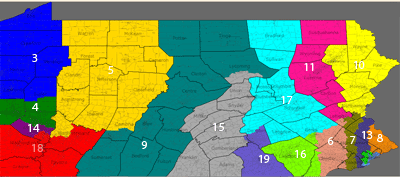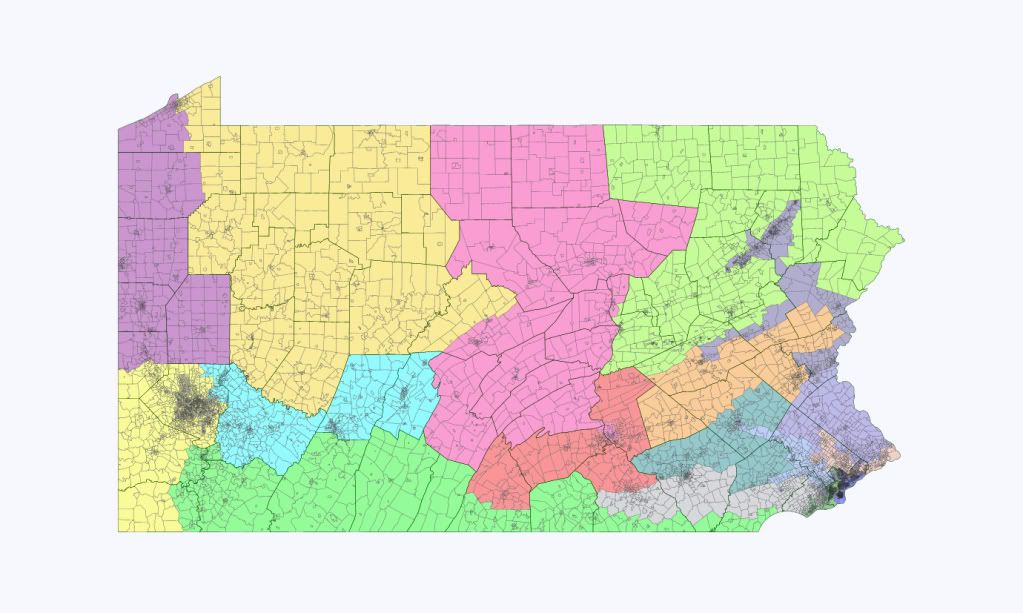Never done a map, so I thought why not.
First, I have no illusions that there is anyway a map that would have the chance to elect 16 Democrats would ever pass the current legislature, let alone survive a veto by Rick Perry.
I just wanted to see if i could a map that had districts that were a little more compact.
Let me just say that I threw out most of the current map and renumbered the districts and probably ended up redistricting a lot of current reps out of their districts.
I also threw out the old numbers. I just have this pet peeve about numbering. I hate to have district 1 and then district 2 on the other side of the state. You can pretty much follow a trail from NE TX to SE TX, over to Houston, down the coast to the border, up to San Antonio, then Austin, then to El Paso, up to the Panhandle and south, then over and north into DFW.

TX-1, Safe Republican
Blue, NE corner of the state.
76% White, 16% Black, 7% Hispanic, 2% Asian
70% McCain/29% Obama
I think I redistricted Louie Gohmert out of this district and into the 2nd, which contains most of his old district.
TX-2, Safe Republican
Green, east Texas
73% White, 16% Black, 9% Hispanic, 1% Asian
70% McCain/29% Obama
TX-3, Safe Republican
Dark Magenta, SE corner of the state.
63% White, 21% Black, 13% Hispanic, 3% Asian
59% McCain/41% Obama
I gave the Golden Triangle (Beaumont, Port Arthur, & Orange) it’s own district. I redistricted Ted Poe out of this district. Although it’s a 60-40 district, I think someone like Nick Lampson could have a chance in it since it contains both Beaumont and Galveston.

TX-4, Safe Republican
Red, just north of Harris County (Houston)
77% White, 13% Hispanic, 8% Black, 2% Asian
73% McCain/26% Obama
Although it has less population than the other districts, it’s a fast growing area that will likely grow. I also figured why not give the Houston suburbs their own district.
TX-5, Safe Republican
Gold
67% White, 15% Hispanic, 11% Black, 6% Asian
62% McCain/37% Obama
As Houston expands, this area may get more Democratic. I don’t live in the Houston area, so I can’t say for certain.
TX-6, Safe Democratic
Teal
Majority-Minority
37% Hispanic, 33% White, 24% Black, 6% Asian
60% Obama/40% McCain
TX-7, Lean Democratic
Dark Gray
Majority-Minority
41% Hispanic, 40% White, 14% Black, 4% Asian
51% Obama/48% McCain
TX-8, Likely Republican
Slate Blue
Majority-Minority
47% White, 40% Hispanic, 9% Black, 4% Asian
56% McCain/43% Obama
TX-9, Safe Democratic
Cyan
Majority-Minority
33% White, 31% Hispanic, 29% Black, 6% Asian
67% Obama/32% McCain
TX-10, Likely Democratic
Deep Pink
Majority-Minority
34% White, 26% Hispanic, 26% Black, 14% Asian
55% Obama/45% McCain
TX-11, Likely Republican
Chartreuse
56% White, 22% Hispanic, 14% Black, 8% Asian
56% McCain/43% Obama
TX-12, Safe Republican
Cornflower Blue
59% White, 28% Hispanic, 9% Black, 3% Asian
65% McCain/34% Obama
Ron Paul gets to keep his seat. This district combines most of the current 14th and 25th CDs.
TX-13, Lean Democratic
Dark Salmon
Majority-Minority
70% Hispanic, 26% White, 2% Black, 2% Asian
54% Obama/45% McCain
Although it’s a lean Democratic district, the right Democratic shouldn’t have trouble holding it. This district takes in Corpus Christi and Brownsville.
TX-14, Safe Democratic
Olive
Majority-Minority
86% Hispanic, 13% White, 1% Asian
67% Obama/32% McCain
A border district, easy hold.
TX-15, Safe Democratic
Dark Orange
Majority-Minority
88% Hispanic, 10% White, 1% Asian
68% Obama/31% McCain
This district is anchored by Laredo. Henry Cuellar gets to keep his job.
TX-16, Safe Democratic
Lime
Majority-Minority
71% Hispanic, 20% White, 7% Black, 2% Asian
66% Obama/33% McCain
Encompasses most of San Antonio. Charlie Gonzalez gets to keep his job.
TX-17, Toss Up
Dark Slate Blue
Majority-Minority
50% Hispanic, 41% White, 5% Black, 3% Asian
50% Obama/49% McCain
This would be my new district. I took in more of San Antonio and Bexar County and was able to cut down the size of this district. Rather than stretching to El Paso, it now only goes to Del Rio. In addition to cutting down the size, I also cut out a lot of the Republican areas in northern Bexar County that really came out in 2010 (such as Fair Oaks Ranch and Stone Oak). Ciro Rodriguez could probably win this district.
TX-18, Safe Republican
Yellow
64% White, 26% Hispanic, 7% Black, 3% Asian
62% McCain/37% Obama
Democrats in the NE part of Bexar County won’t like it, but I made Lamar Smith’s district much more Republican. I took those Republican areas from Ciro’s old district (haven’t gotten used to having Canseco yet) and gave them to Lamar Smith. Austin Democrats should love this district because no longer do they have to deal with Lamar Smith.
TX-19, Safe Democratic
Lime Green
56% White, 30% Hispanic, 8% Black, 6% Asian
68% Obama/30% McCain
Here’s another reason Austin Democrats should love this map…Austin gets its own district. Welcome back to a compact district Lloyd Doggett.
TX-20, Toss Up
Pink
65% White, 23% Hispanic, 8% Black, 4% Asian
50% Obama/49% McCain
Thanks to Travis, Bastrop, and Hays Counties, this district is a toss up and may continue in the Democratic direction.
TX-21, Safe Republican
Maroon, West Texas and Border
57% White, 38% Hispanic, 3% Black, 2% Asian
71% McCain/28% Obama
This district combines a lot of the current 23rd as well as the current 11th. This district is dominated by San Angelo, Midland, & Odessa.
TX-22, Safe Democratic
Sienna
Majority-Minority
76% Hispanic, 18% White, 3% Black, 2% Asian
65% Obama/34% McCain
Silvestre Reyes gets to keep his El Paso district.
TX-23, Safe Republican
Aquamarine, Panhandle
66% White, 26% Hispanic, 6% Black, 2% Asian
74% McCain/25% Obama
Republicans keep breaking up Austin, so I thought I’d combine Amarillo and Lubbock and let them fight over one district.
TX-24, Safe Republican
Indigo, West Texas
70% White, 22% Hispanic, 6% Black, 2% Asian
74% McCain/25% Obama
Abilene is the biggest city here. Charlie Stenholm might have been able to win this district.
TX-25, Likely Republican
Pale Violet Red
69% White, 16% Hispanic, 11% Black, 4% Asian
55% McCain/43% Obama
North of Austin it takes in Williamson County and Killeen.

TX-26, Safe Republican
Gray
67% White, 16% Black, 14% Hispanic, 2% Asian
66% McCain/33% Obama
Waco is the predominant city here.
TX-27, Safe Republican
Red
86% White, 9% Hispanic, 3% Black, 2% Asian
75% McCain/25% Obama
TX-28, Likely Republican
Dark Green
64% White, 24% Hispanic, 8% Black, 4% Asian
57% McCain/42% Obama
Western Tarrant County/Fort Worth. Depending on where she resides, this district could be ripe in some years for a Congresswoman Wendy Davis.
TX-29, Lean Democratic
Dark Sea Green
54% White, 21% Black, 18% Hispanic, 6% Asian
53% Obama/47% McCain
SE Tarrant County/Fort Worth and Arlington. If Wendy Davis wanted a better district right away, she could choose this one.
TX-30, Safe Republican
Yellow
80% White, 9% Hispanic, 5% Asian, 5% Black
65% McCain/34% Obama
TX-31, Safe Republican
Khaki
76% White, 11% Hispanic, 7% Asian, 6% Black
60% McCain/39% Obama
TX-32, Likely Republican
Cyan
67% White, 14% Hispanic, 11% Asian, 8% Black
57% McCain/42% Obama
TX-33, Safe Republican
Dark Goldenrod
78% White, 12% Hispanic, 7% Black, 2% Asian
69% McCain/30% Obama
TX-34, Toss Up
Lime Green
Majority-Minority
47% White, 35% Hispanic, 11% Black, 7% Asian
50% Obama/49% McCain
As Dallas goes more Democratic, so should this district.
TX-35, Toss Up
Dark Orchid
53% White, 27% Hispanic, 15% Black, 4% Asian
50% Obama/49% McCain
Second verse, same as the first.
TX-36, Safe Democratic
Orange
Majority-Minority
41% Black, 31% Hispanic, 26% Black, 2% Asian
80% Obama/20% McCain



























